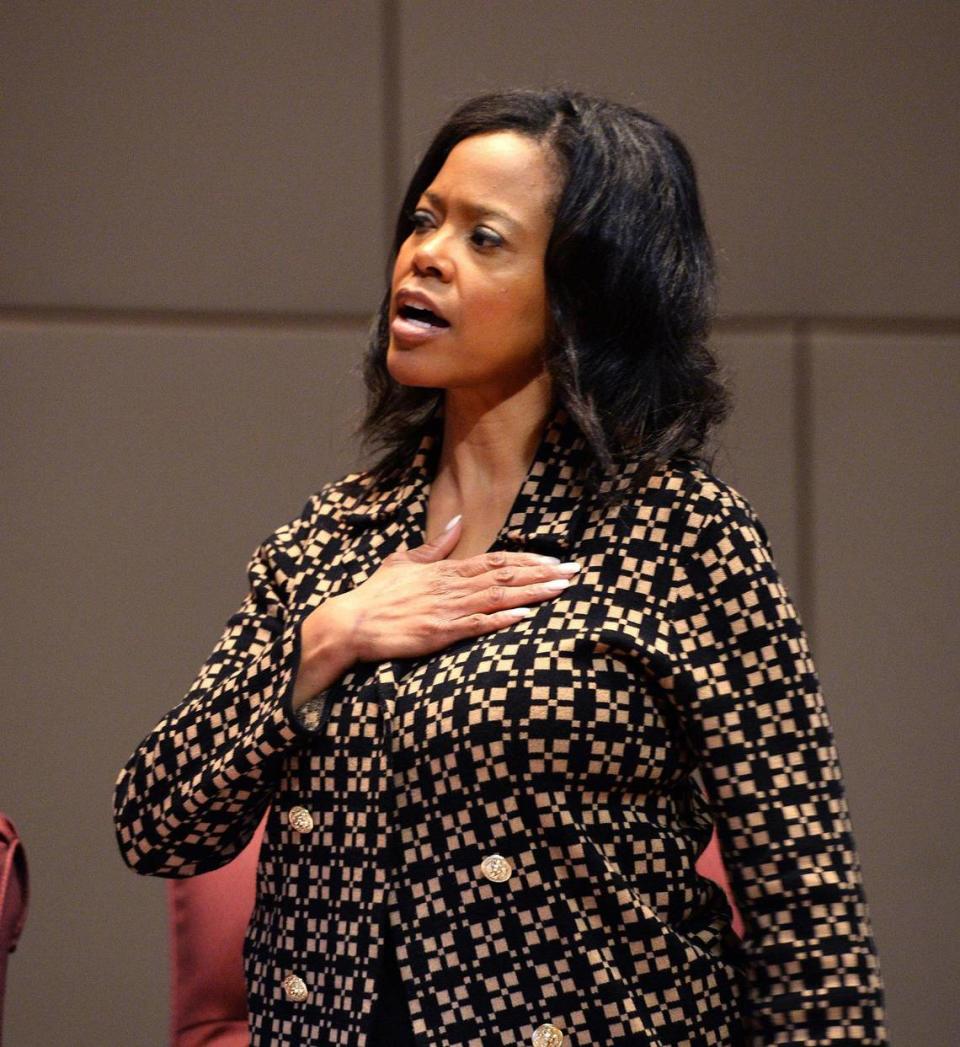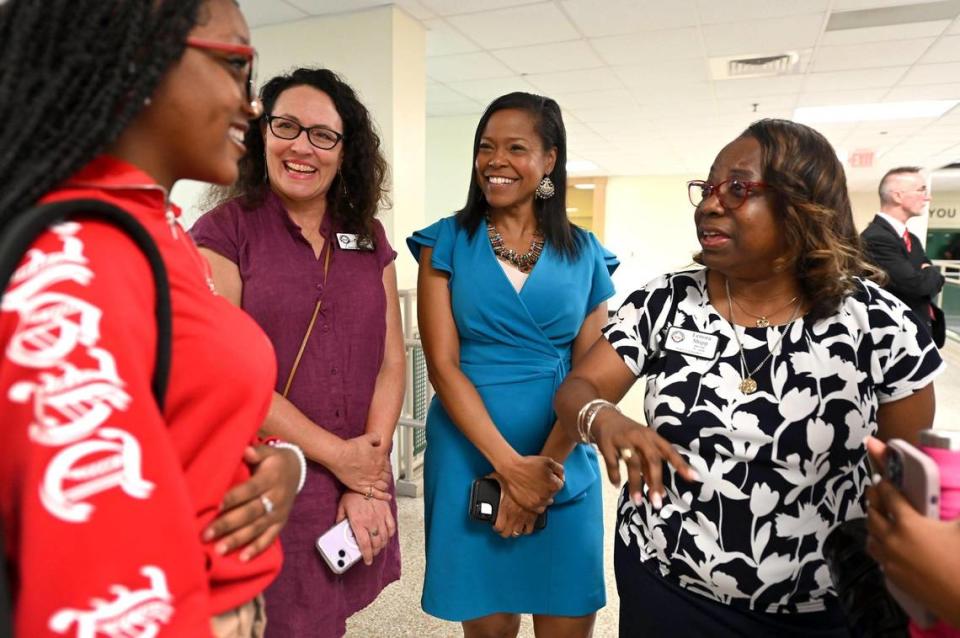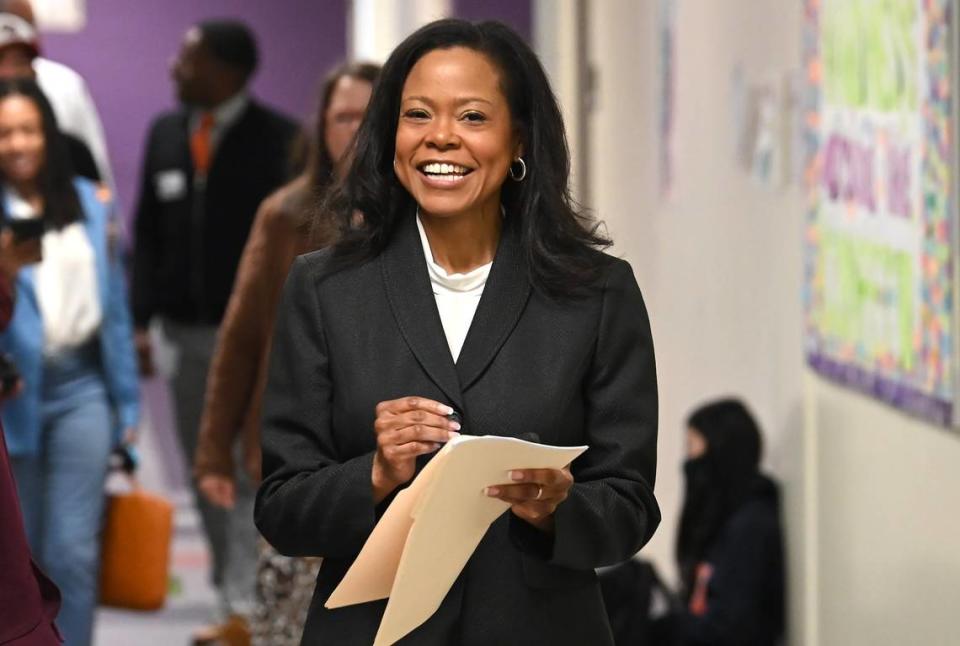CMS will see a leadership realignment this year. The change will bring ‘culture we want.’
Charlotte-Mecklenburg Schools Superintendent Crystal Hill says employees shouldn’t be concerned about losing their jobs as the district shifts how it manages schools to meet student achievement goals.
On Jan. 5, Hill announced plans to restructure the district’s leadership configuration. Starting in the 2024-25 academic year, CMS will transition from learning communities that group schools by where they sit in Mecklenburg County to a new model “that ensures the success of every student.”
The nine learning communities — led by a designated superintendent — keep students in the same area through graduation and “support better high schools” and those that feed into them, according to CMS. The new model, which will group schools around education levels, “supports and reinforces the culture we want” and delivers on goals set by the CMS Board of Education, Hill said.
“There will be changes, but we are really blessed in Mecklenburg County, and we are working to make sure that we do not have a reduction of force or layoffs,” she said.
Hill, who spoke with The Charlotte Observer on Friday, outlined her goals to improve opportunity, provide equity and place leaders in positions to impact education through the plan that’s expected to start July 1.
The following Q&A with Hill has been edited for clarity and brevity.
Q. Why is this change being made now to move away from regional learning communities?
The summer I was hired into the district in 2022 under the leadership of interim Superintendent Hugh Hattabaugh, the district went from six learning communities to nine learning communities. That was obviously because the community was growing and also wanted to minimize the number of principles repeated in each learning community. In that model, because it’s geographic, the learning community superintendent was responsible for serving students in pre-K, 3-year-olds all the way up to 18 and 19-year-olds.
So, the scope of what we had our learning communities in charge of was very large. The new model focuses on grade standards. So, we will have five different superintendents for school performance that are focused on elementary, two that are focused on middle school and two that are focused on high school. And then there will be one that has a focus on kindergarten to eighth grade. It reduces the number of principals reporting to each assistant superintendent, which allows those folks to be in school every week, coaching and supporting principals to support students.
And the other thing that it does is it narrows their scope. We have four goals. The first goal is third-grade reading for Black and Hispanic students. Our second goal is math one. Our third goal is high school graduation. Our fourth goal is exceeding on academic growth. But none of those talks about high school graduation rates.
High school graduation rate is significant, even though it’s not one of our goals. So, with our new model, having two folks who are focused on high schools, those people will be keenly aware of each other accountability measures that aren’t necessarily goals that are listed by the school board.

Q. How much of the reorganization was motivated by improving achievement scores, graduation rates and everything else?
It’s motivated by improving educational outcomes for all those that are captured in our goals as well as other accountability measures. The test scores would be one goal. Graduation rate and access for students along with more post-secondary readiness courses, all of those things.
The other thing I will say is we’re going after a good student experience. I’m really big on customer service. And we know that our students are consumers, and our parents and our families are our customers. And so what I want to explore is that access and equity that happens on one side of town is also the same access and equity on the other side of town.
Five people will be leading the charge of our elementary schools. Those people will be charged with developing the core educational experience of every student who is in elementary school to provide access to equity. What type of education should they have? Right now, there is a level of variability across our districts because it’s so large, and that is something we’re currently working on.
Q. So, how will the district try to make equity as realistic as possible in the new model?
If anything, this plan makes it more equitable. Instead of nine people being responsible for pre-K to 12th grade for their entire region, we have five solely focused on elementary schools. So, those are five people who need much more focus.
We’re also galvanizing our resources and putting them where students need them the most. We have federal funds that are specifically earmarked for improving educational outcomes for students who may be economically disadvantaged. We’re laser-focused to make sure that those dollars are being used towards strategies that will guarantee good outcomes for our students.
Q. CMS wants to provide support for school leaders. Does that also include teachers as well?
The number one thing we need to take care of is the retention and recruitment of our teachers. So I moved Nancy Brightwell, chief academic officer, out of academics and basically created a whole new division that is solely focused on recruitment, retention and development, specifically of our teachers. We’re finding that in the 2022-23 school year over 51% of our new teachers who came to CMS had not gone through a teacher education program. So, they were alternatively licensed teachers, meaning they went to school for business and then decided they wanted to teach.
They were on the pathway to getting a license to teach, and we were able to license them provisionally. But basically 51% of our teachers, when they arrived on day one, didn’t have all of the training and development that a typical teacher would have. So, this new division will be responsible for ensuring that our teachers are classroom-ready by going through a supportive onboarding process before they ever step foot in the classroom.

Q. Before deciding to make this organizational shift district-wide. How much were the needs of parents and students considered?
We asked what we need to do to achieve these goals because at that time the school board had drafted four goals. Their goals took into account all of the input from the community that they had gathered.
So, we engaged the community last spring of 2023 and all summer. They had thousands of pieces of data about what parents were saying. And then we went out and asked the community, “Okay, based on these four new draft goals, what do you need to do to achieve?” They said, “You need to have teachers that are ready to walk into the classroom. You need to make sure that you have teachers that stick with us and also all the support pieces.”
So that was like the No. 1 answer that they gave. And so we did get all of the information in terms of what the community wanted for their child, for their children, and our entire community.
Q. How will CMS measure success with the reorganization effort?
The 2024-25 school year starts on July 1, which is why we are collecting all this process now. So, I will be evaluated as the superintendent, and the community will evaluate us as a district based on the attainment of our goals. We have annual goals for each one, so even though it’s a five-year plan from 2024 through 2029 for each year of that goal.
For the 2024-25 school year, there are specific targets or goals. And then every board meeting, which is essentially every two weeks, the board goes through a process of progress monitoring, asking these questions about strategies that we’ve implemented and results that we’re getting. The purpose of that progress monitoring — where they’re asking me questions — is to make sure that the board feels comfortable that the strategies that I’ve put in place are yielding the results that they require. So, our measure of success will be goal attainment for each target for the year.
Q. Will everyone who’s currently employed by CMS be able to keep their jobs? Or, will there be as many jobs after the switch as currently exist?
There will be changes, but we are really blessed in Mecklenburg County, and we are working to make sure that we do not have a reduction of force or layoffs. There will be different jobs that will be offered. There will be some jobs that will be eliminated. There will be some jobs that are created. This is not about how do we shed people from Charlotte-Mecklenburg Schools. Absolutely not.
We have strong people in Charlotte-Mecklenburg Schools. We just need to make sure that the people are in jobs that are aligned to get us the goals that we need because the board and the community will be holding me and our district accountable for achieving those goals. There should be no concern about any employee in this district about having a job.

Q. Were there other options considered before CMS settled on the current reorganization plan?
We did think about other options. I think that the number one consideration is always doing what’s in the best interest of the students. So there are lots of things that we thought about, but when it all boils down to it, the reason why I have a job — the reason why Charlotte-Mecklenburg Schools exists — is to ensure we are doing what’s in the best interest of children. This is what I believe is absolutely 100% the best thing for students.

